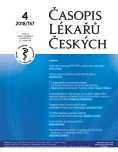Interventional radiology therapies for liver cancer
Authors:
Tomáš Andrašina; Tomáš Rohan; Jakub Hustý; Vlastimil Válek
Authors‘ workplace:
Klinika radiologie a nukleární medicíny LF MU a FN Brno
Published in:
Čas. Lék. čes. 2018; 157: 195-202
Category:
Review Article
Overview
Radiological methods and procedures have become not only an inseparable part of the diagnosis of primary and secondary liver tumors, but also therapy and disease management of patients with colorectal cancer. The most common primary liver cancer, hepatocellular carcinoma, can be treated with curative intent by surgical approach as well as navigational radiological interventions. Palliative methods include transarterial chemoembolization, which is suitable for more than half of patients during treatment. extends treatment options even in patients with metastatic colorectal cancer who fail at standard therapies. In addition to thermal ablation in oligometastatic disease, intravascular procedures (chemoembolization and regional chemotherapy, preoperative portal vein embolization) can be used. By modern intervention approaches in patients with malignant biliary tract stenosis, we are able to refine and accelerate the diagnosis, to improve quality of life and to extend patients’ survival.
Keywords:
liver tumors, thermal ablation, chemoembolization
Sources
1. Li Y, Jia Y, Li S et al. Transarterial chemoembolization of giant liver haemangioma: a multi-center study with 836 cases. Cell Biochem Biophys 2015; 73(2): 469–472.
2. Shafi B. Percutaneous radiofrequency ablation of liver tumors: background, indications, contraindications. Medscape, 2017 Nov 7. Dostupné na: https://emedicine.medscape.com/article/1390475
3. Ryan MJ. Ablation techniques for primary and metastatic liver tumors. World J Hepatol 2016; 8(3): 191.
4. Tanis E, Nordlinger B, Mauer M et al. Local recurrence rates after radiofrequency ablation or resection of colorectal liver metastases. Analysis of the European Organisation for Research and Treatment of Cancer #40004 and #40983. Eur J Cancer 2014; 50(5): 912–919.
5. Wang X, Sofocleous CT, Erinjeri JP et al. Margin size is an independent predictor of local tumor progression after ablation of colon cancer liver metastases. Cardiovasc Intervent Radiol 2013; 36(1): 166–175.
6. Ruers T, Van Coevorden F, Punt CJA et al. Local treatment of unresectable colorectal liver metastases: results of a randomized phase II trial. J Natl Cancer Inst 2017 Mar 17; 109(9), doi: 10.1093/jnci/djx015.
7. Vandenbroucke F, de Mey J. Absolute and relative contraindications of radiofrequency ablation of focal liver tumors. ECR 2009, poster C-552, doi: 10.1594/ecr2009/C-552. Dostupné na: https://posterng.netkey.at/esr/viewing/index.php?module=viewing_poster&task=&pi=40613
8. Venkatesan A, Gervais D, Mueller P. Percutaneous radiofrequency thermal ablation of primary and metastatic hepatic tumors: current concepts and review of the literature. Semin Interv Radiol 2006; 23(1): 73–84.
9. Dodd GD, Soulen MC, Kane RA et al. Minimally invasive treatment of malignant hepatic tumors: at the threshold of a major breakthrough. Radiogr Rev Publ Radiol Soc N Am Inc 2000; 20(1): 9–27.
10. Correa-Gallego C, Fong Y, Gonen M et al. A retrospective comparison of microwave ablation vs. radiofrequency ablation for colorectal cancer hepatic metastases. Ann Surg Oncol 2014; 21(13): 4278–4283.
11. Yang Y, Wang C, Lu Y et al. Outcomes of ultrasound-guided percutaneous argon-helium cryoablation of hepatocellular carcinoma. J Hepatobiliary Pancreat Sci 2012; 19(6): 674–684.
12. European Society for Medical Oncology. Hepatocellular Carcinoma: ESMO-ESDO Clinical Practice Guidelines. Dostupné z: www.esmo.org/Guidelines/Gastrointestinal-Cancers/Hepatocellular-Carcinoma
13. Livraghi T, Meloni F, Stasi MD et al. Sustained complete response and complications rates after radiofrequency ablation of very early hepatocellular carcinoma in cirrhosis: is resection still the treatment of choice? Hepatology 2008; 47(1): 82–89.
14. Song JE, Kim DY. Conventional vs drug-eluting beads transarterial chemoembolization for hepatocellular carcinoma. World J Hepatol 2017; 9(18): 808.
15. Galle PR, Forner A, Llovet JM et al. EASL Clinical Practice Guidelines: Management of hepatocellular carcinoma. J Hepatol 2018; 69(1): 182–236.
16. Lencioni R, Llovet JM, Han G et al. Sorafenib or placebo plus TACE with doxorubicin-eluting beads for intermediate stage HCC: the SPACE trial. J Hepatol 2016; 64(5): 1090–1098.
17. Loffroy R, Favelier S, Chevallier O et al. Preoperative portal vein embolization in liver cancer: indications, techniques and outcomes. Quant Imaging Med Surg 2015; 5(5): 730–739.
18. van Lienden KP, van den Esschert JW, de Graaf W et al. Portal vein embolization before liver resection: a systematic review. Cardiovasc Intervent Radiol 2013; 36(1): 25–34.
19. Boulay BR, Birg A. Malignant biliary obstruction: from palliation to treatment. World J Gastrointest Oncol 2016; 8(6): 498.
20. Park JG, Jung GS, Yun JH et al. Percutaneous transluminal forceps biopsy in patients suspected of having malignant biliary obstruction: factors influencing the outcomes of 271 patients. Eur Radiol 2017; 27(10): 4291–4297.
21. Yarmohammadi H, Covey AM. Percutaneous biliary interventions and complications in malignant bile duct obstruction. Chin Clin Oncol 2016; 5(5): 68.
22. Biagioli M, Wen BC, Patton B et al. Cholangiocarcinoma: the impact of endobiliary high-dose-rate (HDR) brachytherapy dose response on survival. Brachytherapy 2006; 5(2): 91.
23. Mizandari M, Kumar J, Pai M et al. Interventional radiofrequency ablation: a promising therapeutic modality in the management of malignant biliary and pancreatic duct obstruction. J Cancer 2018; 9(4): 629–637.
Labels
Addictology Allergology and clinical immunology Angiology Audiology Clinical biochemistry Dermatology & STDs Paediatric gastroenterology Paediatric surgery Paediatric cardiology Paediatric neurology Paediatric ENT Paediatric psychiatry Paediatric rheumatology Diabetology Pharmacy Vascular surgery Pain management Dental HygienistArticle was published in
Journal of Czech Physicians

Most read in this issue
- Hybrid imaging PET/MR in prostatic carcinoma
- Coronary CT angiography – current options and future perspectives in the diagnosis of coronary artery disease
- Contrast-enhanced ultrasonography
- Interventional radiology therapies for liver cancer
